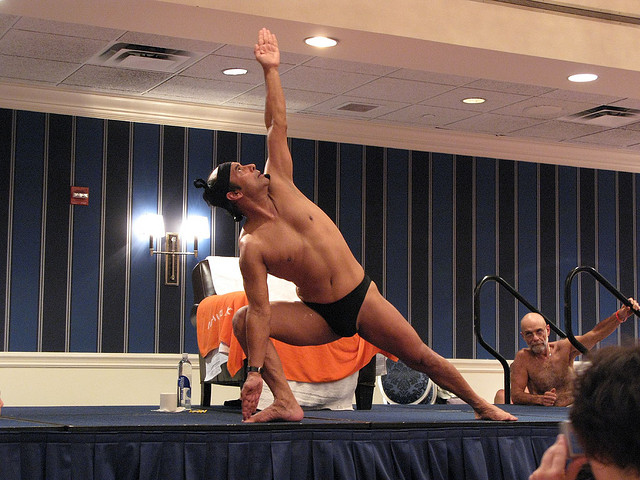Hot yoga in hot water: The Ninth Circuit Court of Appeals in California has affirmed a previous ruling by a federal district court that Bikram Choudhury’s sequence of 26 yoga poses is not entitled to copyright protection.
I have to admit to feeling a bit of unkind glee when I saw the decision against Bikram Choudhury’s attempt to copyright his yoga sequence.
The decision has, for all intents and purposes, created joy in many sectors of the Yoga world, while creating disappointment for Bikram devotees.
There—I said it.
And I don’t think I’m the only one.
Yoga, as we all know, has been around for centuries. What I didn’t know (and maybe I should have) was that it was actually popular among some of the great literati—including Thoreau and Emerson.
Who knew that? I certainly didn’t learn that in my English Literature classes —that would’ve made that class a whole lot more interesting! So my idea of yoga as a “recent” import, or something that came to the U.S. in the 1960s and 70s, is certainly proved wrong, to my own delight.
The Court brings out many details, which to some folks seem nit-picky and obscure. But to those of us who actually enjoy reading legal opinions, and delving into the twists and turns of a great legal argument, there are some gems here.
In full disclosure, I’m not a lawyer (nor do I play one on television)—but from 8 a.m. to 5 p.m. during the week, I’m a family law paralegal, who very much enjoys the geeky side of the law. Had I gone to law school, my dream job would’ve been research, tucked away in some library.
So what I’m saying is certainly my own opinion, as to the decision of the United States Court of Appeals for the Ninth Circuit in this case. My opinion is one of many—my father used to say that “opinions are like noses—everyone has one.” In reading the decision of the Court against Bikram’s Yoga College (Bikram’s Yoga College of India LP and Bikram Choudhury v. Evolation Yoga), one thing jumped out at me.
On page 16 of the decision, the Court is discussing the idea that Choudhury claims copyright protection because his particular sequence is a compilation. Well, that presents a number of difficulties. After all, many things are compiled. Recipes are compiled. Instructions are compiled. Dictionaries are compiled. And many of those compilations are indeed copyrighted. But here—well, here it gets interesting, because the Court says:
“A compilation must, in other words represent an ‘original work of authorship,’ and [i]n no case may copyright protection extend to any idea, procedure, process, [or] system.”
The Court says that the law provides that any compilation must meet a standard where the end result is an original work. Choudhury didn’t invent Yoga, even if in some of his interviews he tries to make it sound like he did.
Color me skeptical, but as a yoga teacher, I know enough to truly believe that yoga can do many wonderful things. But, I have never, ever told a student (as Bikram has said) that a particular system of yoga “is capable of helping you avoid, correct, cure, heal…the symptoms of almost any illness or injury.” (p. 5 and p. 11)
The Court went on to find that the concept of beauty (which was another think Bikram claims as a benefit—that his Sequence was beautiful and flowing) was not a basis for the protection of a copyright.
Which is a practical thing—who determines beauty? What kind of beauty should (or could) be copyrighted? Isn’t beauty a lot like someone’s concept of pornography—“I’ll know it when I see it,” has been the standard argument. Some folks find beauty in Body Fluid Art (yes, that’s painting with bodily fluids). Me? I’ll take a nice flower, preferably by Georgia O’Keeffe. Or a stunning photograph of the mountains by my hubby.
The Court rightly affirmed that ideas, processes and systems are not entitled to copyright protection. Nor is the concept of beauty to be copyrighted. To copyright an idea, or a process, would inevitably lead to stifling of all creativity. It’s been argued that there are “no new stories” and “too few new ideas.” To copyright beauty? You can’t copyright such an ethereal concept such as beauty, which truly transcends all cultures and all peoples.
In yoga, one can stretch one’s mind as well as one’s body. To copyright these ancient concepts is to claim ownership of that art. Ownership by one individual—of a particular set of yoga poses—in my opinion, is wrong.
As a yoga teacher, I know that I have tapped into other teachers’ sequences and ideas. And I know other teachers have tapped into mine. In any given gathering of yoga teachers, you can practically see this happening—like a physical phenomenon blooming right before one’s eyes.
Together, we as teachers continue to give life to the body of yoga. We have created a community in which we are free to exchange ideas and concepts. Together, we make a group of people who show others how to transform themselves through the study and practice of yoga.
The idea of one person copyrighting one specific sequence—and then suing someone who used that sequence—felt wrong when I heard that it had been done, and I for one am glad that the Ninth Circuit affirmed that there are some things which simply are not protected under copyright law.
.
Relephant:
A Letter to the Bikram Community.
How Bikram Unintentionally Inspired the Evolution of Hot Yoga.
.
Author: Pat Perrier
Editor: Yoli Ramazzina
Photo: Flickr/Yaniv Nord



Read 4 comments and reply